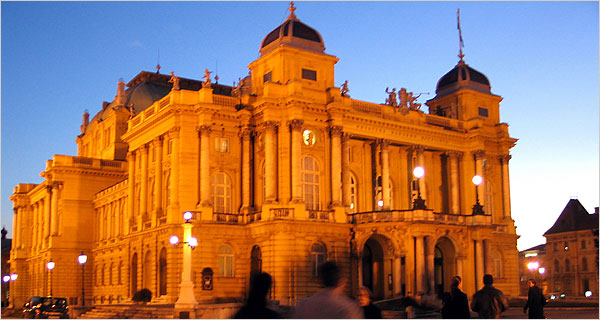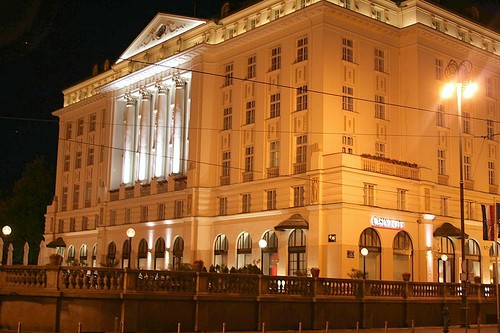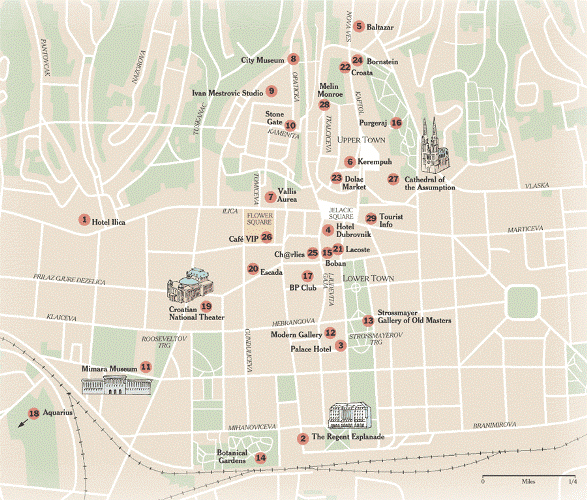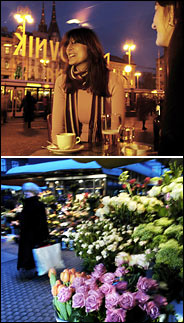Who Needs Venice When Zagreb Beckons?  |
The Croatian National Theater (Hrvatsko Narodno Kazalište) was designed by famed Viennese architects Ferdinand Fellner and Herman Helmer. It was opened in 1895.
Photo: Carly Calhoun for The New York Times
|
Take Vienna's florid architecture, throw in Budapest's bubbling cafe culture, and you get Zagreb, Croatia's grand capital. A showcase of fin-de-siecle architecture capped by not one, but two hilltop medieval towns, Zagreb's unexpected beauty is drawing sophisticated weekenders.
One could spend an entire day just wandering from cafe to cafe on Trg Bana Jelacica, the main square, chatting with the friendly and fashionable locals. At night, the action moves to the city's old-style restaurants. At the rustic favorite Vallis Aurea (Tomiceva 4; 385-1-48-31-305), you can order hearty dishes like pork cutlets or rump steak for under 8 euros. Afterward, cross the street to Vinoteka Pantheon (Tomiceva 5; 385-1-48-33-907), a chic new bar that serves Croatian delicacies and wine.
The shopping is surprisingly good, too. All the global fashion labels are present, but residents are just as likely to peruse the Hrelic flea market on Sunday mornings for 1960's chandeliers and Modernist furniture. The one thing Zagreb lacks is designer hotels, which is just as well, considering that grand places like the Hotel Dubrovnik (Gajeva 1; 385-1-4863-555;
www.hotel-dubrovnik.hr), on Trg Bana Jelacica, start at just 120 euros (about $165).
Source:
http://travel.nytimes.com/2007/04/22/travel/22surfacing.htmlGoing to Zagreb By ALEX CREVAR
Published: May 1, 2005
 |
| The Hotel Esplanade |
There's a bubbling just below the surface in Zagreb, the Croatian capital of one million people, and most visitors sense it instantly. It's a well-worn, East-meets-West passion called Balkan culture that equally embraces a consumer's desire to visit a newly opened fragrance shop and the cafe next door where an entire goat turns slowly on a spit.
On just about any weekend afternoon, you'll find shoppers strolling along Ilica, the city's main promenade, toting Max Mara and Louis Vuitton bags. They pass vendors selling chestnuts and cafes with rich wood interiors and billowy couches on marble floors. The promenade gives way to the busy, expansive Jelacic Square where people cluster beneath bistro awnings or near theaters.
In Zagreb, one of the most overlooked cities in Europe, high fashion, more than 50 museums and galleries, and an urban plan simple enough for the most directionally challenged combine intriguingly with the charms and chutzpah of an Old World city that is still coming to grips with modernity.
But as Zagreb dons a new attitude, one might presume its main goal is to prepare for hordes of tourists taking advantage of a non-euro economy. Not so, says an official at Zagreb's Office for Culture, Davor Zagar, who notes that the makeovers to theaters and pedestrians zones, along with an expanded social calendar - keeping jazz aficionados as happy as folkloric dancers - are as much for Purgers (Zagrebians) as they are for tourists.
 |
| Map of Zagreb. Numbers in the article correspond to numbers on this map. |
 |
Carly Calhoun for The New York Times
TOP The Dubrovnik Hotel's cafe looks out on the central Jelacic Square. BOTTOM Stalls in Flower Square.
|
Where to StayZagreb's lack of tourism savoir-faire is a boon for those hoping to unearth the undiscovered. But when it comes to hotels, this doesn't necessarily translate into bargains. An adequate option starting at $72 a night, at 5.75 kuna to the dollar, is the tidy, comfortable 22-room Hotel Ilica, (1) conveniently situated at Ilica 102, (385-1) 377-7622,
www.hotel-ilica.hr.
But most hotels in Zagreb's center were built for a bourgeois set that started visiting at the end of the 19th century. The grand Regent Esplanade (2) was recently reopened after a restoration of its Carrara marble and Art Deco interior. Situated next to the train station - itself a renovated neo-classical gem - at Mihanoviceva 1, the Esplanade was built in 1925 as a posh stop along the Orient Express. The 209 lavish and "wireless" rooms range from $285 to $1,980. Information: (385-1) 456-6666,
www.regenthotels.com.
Built in 1891 in the Secessionist style, the Palace Hotel, (3) Strossmayerov trg 10, is the city's oldest hotel. About half of the 123 rooms, which cost from $160 to $415, have been renovated, while the others retain the ornate Art Nouveau look. The Palace's plush cafe provides a vantage point from which to watch fashionable Croats gathering in Strossmayer Square. Information: (385-1) 481-4611,
www.palace.hr.
The Hotel Dubrovnik, (4) Gajeva 1, with its glass facade, was opened in 1929. Many of the 266 rooms - all sleekly furnished and equipped with satellite TV - overlook Jelacic (pronounced YEH-lah-chich) Square. Rates range from $140 to $280. Information: (385-1) 487-3555,
www.hotel-dubrovnik.htnet.hr.
Where to EatMost of Zagreb's restaurants offer a combination of the Eastern European, grilled-meat leitmotif and Mediterranean fare. For instance, Baltazar, (5) Nova Ves 4, (385-1) 466-6999, has an upscale-casual ambience. Baltazar's veal medallions or Gaspar's pick-your-own fish pair nicely with dingac (red) or grasevina (white) wines. Try the medovaca, a honey brandy, and enjoy the fireplace in the winter or terrace in summer. A meal for two, with wine, runs about $80.
Kerempuh, (6) at Kaptol 3, (385-1) 481-9000, provides a front-row view of the frenetic Dolac farmer's market and a traditional menu that changes with each day's purchases. The sarma (cooked cabbage stuffed with mincemeat) is wonderful. A meal for two, with drinks, is around $30.
It's a good sign when local residents stare at you as if happily surprised that an outsider discovered their spot. Vallis Aurea, (7) Tomiceva 4, (385-1) 483-1305 - under the funicular connecting Upper and Lower Town - is that kind of place. The smoked pork ribs on Monday or trout on Wednesday are can't-misses. Lunch or dinner with a liter of house wine is $25.
What to Do During the DayZagreb has two halves. Upper Town, the old city dating back to the 11th century, is chock-full of red tile roofs and cobblestones privy to a millennium of secrets. Lower Town is a 19th-century invention, where most of the city's museums are intertwined with parks and cafes. The synapse linking this yin and yang is Jelacic Square. Jelacic is the hub for the rumbling trams (fare is about $1) that crisscross town.
The City Museum, (8) Opaticka 20, (385-1) 485-1364, www.mdc.hr/mgz, tells Zagreb's story, complete with room-sized models of town, starting in 1094, when the Hungarian King Ladislaus I founded the bishopric of Zagreb. Admission is about $3.50; closed Monday.
Also in Upper Town, Ivan Mestrovic's Studio, (9) Mletacka 8, (385-1) 485-1123,
www.mdc.hr/mestrovic/atelijer/opci-en.htm, ($3.50), is where Croatia's most famous sculptor worked and many of his pieces still stand.
Southeast of the museums, the Upper Town's remaining feudal Stone Gate (Kamenita Vrata) (10) is a holy site, where the devout light candles before a painting of the Virgin Mary and Jesus that survived a devastating fire in 1731.
You'll shift into the 19th century as you stroll past the Lower Town's Viennese-style, pastel mansions. The Mimara Museum (11) - Zagreb's major art museum - at Rooseveltov trg 5, (385-1) 482-8100, has a collection that includes Greek sculptures, and paintings by Rembrandt and Rubens. Admission $3.50; closed Monday. Nearby is the Modern Gallery, (12) at Hebranga 1, (385-1) 492-2368, ($3.50), with some 10,000 works of Croatian art from the 19th century to the present, and the Strossmayer Gallery of Old Masters, (13) Trg Nikole Subica Zrinskog 11, (385-1) 489-5117, ($1.75), displaying pieces by such artists as El Greco and Bellini.
Anchoring the "green horseshoe, " a U-shaped series of parks that envelope Lower Town, is the 11.6-acre Botanical Gardens, (14) Trg Marulica 9a, (385-1) 484-4002. Free.
What to Do at NightThere seem to be as many cafe-bars in Zagreb as people; most of them charge around $2 for a beer or a glass of wine. Boban, (15) Ljudevita Gaja 9, (385-1) 481-1549,
www.boban.hr, is atrendy restaurant and cafe-bar a block south of Jelacic. It has outdoor seating,and attracts trendy tourists and locals alike.
For live music, there are many clubs that charge little or no cover. Near the mammoth cathedral, Purgeraj, (16) Park Ribnjak 1, (385-1) 481-4734,
www.purgeraj.hr, attracts an eclectic crowd for everything from rockabilly to disco.
The BP Club, (17) Teslina 7, (385-1) 481-4444,
www.bpclub.hr, is owned by Croatia's top jazzman, the vibe master Bosko Petrovic. Solid players regularly show up and when they do, the small, mirrored interior seems to vibrate.
Southwest of the center, on Lake Jarun, Aquarius, (18) (385-1) 364-0231,
www.aquarius.hr, ($11 cover), plays host to a stream of international guest D.J.'s.
There are, of course, many ways to spend an evening. The Croatian National Theater, (19) Trg marsala Tita 15, (385-1) 482-8532,
www.hnk.hr, is the main venue for opera and drama. Verdi's "Traviata" will be presented in June. Ticket prices range from about $6 to $35.
Where to ShopHeading west from Jelacic, Ilica is packed with boutiques, where one can find local fashion and international designs, staggered with art, fishmongers and ice cream shops. Just off Ilica, between the so-called Flower Square (for its flower stalls) and Jelacic are the classy cornerstones Escada, (20) Gunduliceva 15, (385-1) 487-5577, and Lacoste, (21) Frankopanska 12, (385-1) 492-3541.
For local flavor, visit Croata, (22) Kaptol 13, (385-1) 481-4600,
www.croata.hr, specializing in ties and high-end accessories. With your purchase (silk ties are $25 to $70), shoppers can get a lesson about neckties, which originated in Croatia. The French began dressing ŕ la croate in the 1600's, naming the accessory la cravate.
To really shop like a local, head to Dolac, (23) directly above Jelacic. This daily outdoor market has everything from fresh produce to cheeses to wooden toys.
Continue north to Bornstein, (24) Kaptol 19, (385-1) 481-2361, to taste hundreds of labels like Stagnum ($44), made from the Dalmatian varietal plavac mali, a close relative to zinfandel. Closed Sunday.
How to Stay Wired
There are several Internet cafes near Jelacic; most charge about $2.70 an hour. Ch@rlie's, (25) Ljudevita Gaja 4a, (385-1) 488-0233, is open Monday through Saturday from 8 a.m. to 10 p.m. Café VIP, (26) Trg Preradoviceva 5, (385-1) 483-0089, is in the Flower Square.
Your First Time or Your 10thZagreb's calling card is its 344-foot, 788-year-old Cathedral of the Assumption of the Blessed Virgin Mary, (27) Kaptol 31. Meant to inspire awe, its monumental Gothic towers succeed wholeheartedly.
Due west, in Upper Town, is vibrant Tkalciceva Street. This pedestrian-only avenue teems with cafes, where old and young drink espresso and pivo (beer). Melin Monroe, (28) Tkalciceva 47, is an ideal spot to debate who represents Croatia more, the world champion skier Janica Kostelic or the Olympic champion handball team. You'll pay about $2 for a local pivo and $1 for an espresso.
How to Get There
Prices start around $900 from New York, but there are no direct flights. An option is to fly to major cities in Europe and connect with Croatia Airlines,
www.croatiaairlines.com, or Lufthansa,
www.lufthansa.com. Another is to take a train from a more popular airport. Zagreb is on the Venice (seven hours) and Vienna (6.5 hours) lines,
www.hznet.hr.
How to Get AroundZagreb was made for walking. Nearly everything you'll do is a 20-minute trek from Jelacic Square. But when the urge grabs you to explore outside the center - a hike or skiing on Mount Medvednica, for instance - you can take a 15-minute tram ride to the mountain's base. Tram maps can be found at the Tourist Info office, 29 Trg bana Josipa Jelacica 11, (385-1) 481-4051,
www.zagreb-touristinfo.hr.
Source:
http://travel.nytimes.com/2005/05/01/travel/01going.html?_r=1&oref=slogin Formatted for CROWN by Marko Puljić
Distributed by www.Croatia.org This message is intended for Croatian Associations / Institutions and their Friends in Croatia and in the World. The opinions / articles expressed on this list do not reflect personal opinions of the moderator. If the reader of this message is not the intended recipient, please delete or destroy all copies of this communication and please, let us know! Or simply...enjoy and spread the word and good vibrations.